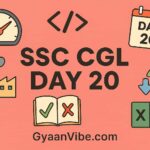GyaanVibe is a focused educational platform dedicated to helping SSC CGL aspirants crack Tier 1 & Tier 2 exam with a strategic, day-wise, and well-structured preparation approach.
SSC CGL Preparation – Day 19
Reasoning – Puzzle Test
📘 Advanced reasoning topic requiring logical sequencing and deduction.
🔍 What is a Puzzle Test?
Puzzle Test questions present you with a set of statements or data about a group of people, objects, or events. Your job is to arrange, match, or analyze them based on the clues provided.
These questions test your ability to interpret complex data and make logical deductions step-by-step.
🎯 Why Puzzle Tests Matter in SSC CGL?
- Commonly seen in Tier 1 (1–2 questions) and Tier 2 (up to 5–8 questions)
- Can be high-scoring if approached methodically
- Time-consuming without practice, but accuracy is high with right techniques
🧠 Types of Puzzle Tests
| Type | Description |
|---|---|
| 1. Linear Arrangement | People/items in a line (left–right or north–south) |
| 2. Circular Arrangement | Sitting around a circle (facing center or outward) |
| 3. Floor-Based Puzzle | Items/people on different floors of a building |
| 4. Scheduling Puzzle | Events on different days/months/time slots |
| 5. Comparison Puzzle | Heights, weights, ranks, etc. comparisons |
| 6. Box Puzzle | Objects stacked in boxes (top to bottom) |
| 7. Attribute Matching | Match name, city, profession, etc. together |
📘 1. Linear Arrangement Puzzle
People are seated in a row (facing North or South).
🧪 Example:
Five friends – A, B, C, D, and E – are sitting in a row.
- B is to the right of A.
- C is at one end.
- E is not next to B.
✅ Approach:
- Draw lines for positions
- Fill definite clues first
- Use elimination and placement
📘 2. Circular Arrangement Puzzle
People sit in a circle. If facing the center, left/right is different than when facing outside.
🧠 Tips:
- Always fix one person’s position
- Note direction facing (important!)
- Visualize left/right accordingly
📘 3. Floor Puzzle
People live on different floors of a building (usually 5–10 floors).
🧪 Example:
There are 5 floors, and 5 people live on different floors.
Clues tell who lives above or below whom.
✅ Approach:
- Draw floor numbers (top to bottom)
- Use statements like “A lives above B”
- Match clues to floors
📘 4. Day/Month/Event Scheduling Puzzle
Events (exams/interviews/birthdays) happen on different days/weeks/months.
✅ Tips:
- Prepare a table (name vs day)
- Use definite statements first
- Eliminate incompatible options step-by-step
📘 5. Comparison Puzzle
Compare heights, weights, ranks, ages, etc.
🧪 Example:
Five people – A, B, C, D, and E.
- A is taller than B but shorter than D.
- C is not the shortest.
- E is the tallest.
✅ Answer: E > D > A > B > C
📘 6. Box Puzzle
Items are kept in stacked boxes (top to bottom). Each box contains a unique object.
✅ Approach:
- Number the boxes from 1 (top) to N (bottom)
- Create slots and fill based on conditions
- Remember: “above” = lower number; “below” = higher
📘 7. Attribute Matching Puzzle
Match multiple attributes like Name, Profession, City, Pet, etc.
✅ Tips:
- Use a table format (rows = people; columns = attributes)
- Apply elimination, direct matches
- Cross-check contradictory clues
🧠 Common Keywords & Their Meaning
| Keyword | Meaning |
|---|---|
| “To the right of” | Directional (only in linear/circular) |
| “Immediately next to” | Adjacent only |
| “Not” | Elimination clue |
| “Exactly between” | There is someone in the middle |
| “Third to the left” | Count 3 places to the left |
| “Lives on an even-numbered floor” | Floors like 2, 4, 6, etc. |
🔑 Puzzle Solving Strategy (for SSC CGL)
| Step | Action |
|---|---|
| 1️⃣ | Read entire question carefully once |
| 2️⃣ | Categorize the puzzle type |
| 3️⃣ | Note clues and visualize structure |
| 4️⃣ | Start with direct clues |
| 5️⃣ | Use elimination and partial placement |
| 6️⃣ | Don’t assume anything not stated |
| 7️⃣ | Practice drawing neat tables or grids |
⚠️ Common Mistakes
| Mistake | Avoid by |
|---|---|
| Misreading left/right | Fix one direction always |
| Assuming unstated info | Stick only to clues |
| Ignoring negations | Pay attention to “not”, “except” |
| Mixing clue types | Group related clues together |




